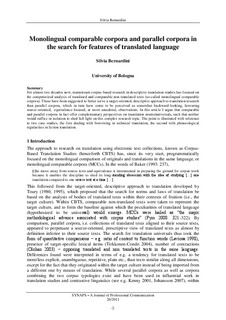| dc.description.abstract | For almost two decades now, mainstream corpus-based research in descriptive translation studies has focused on the computerized analysis of translated and comparable non-translated texts (so-called monolingual comparable corpora). These have been suggested to better serve a target-oriented, descriptive approach to translation research than parallel corpora, which in turn have come to be perceived as somewhat backward-looking, favoring source-oriented, equivalence-focused, at worst anecdotal, observations. In this article I argue that comparable and parallel corpora in fact offer complementary perspectives on translation norms/universals, such that neither would suffice in isolation to shed full light on this complex research topic. The point is illustrated with reference to two case studies, the first dealing with borrowing in technical translation, the second with phraseological regularities in fiction translation. | nb_NO |
